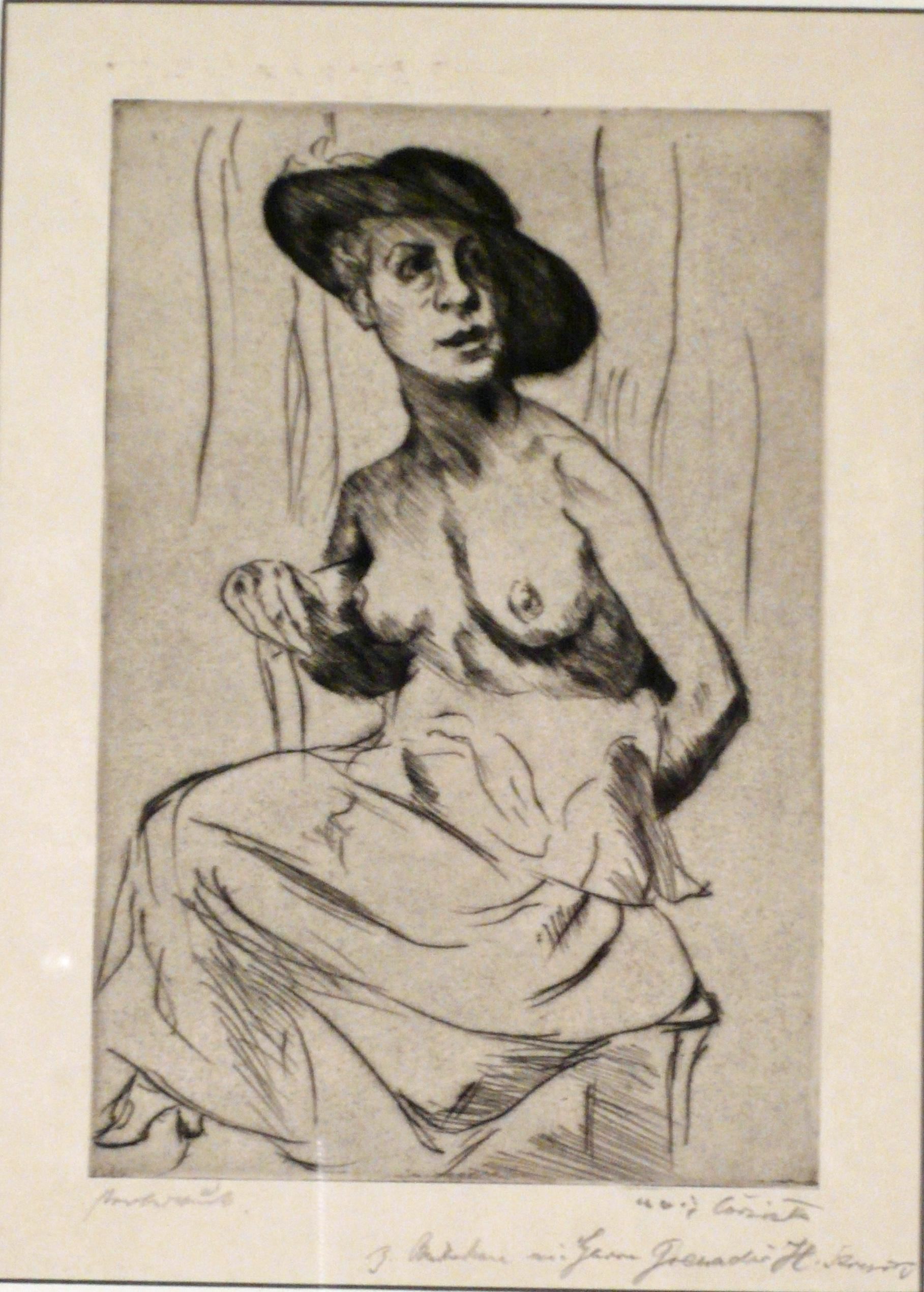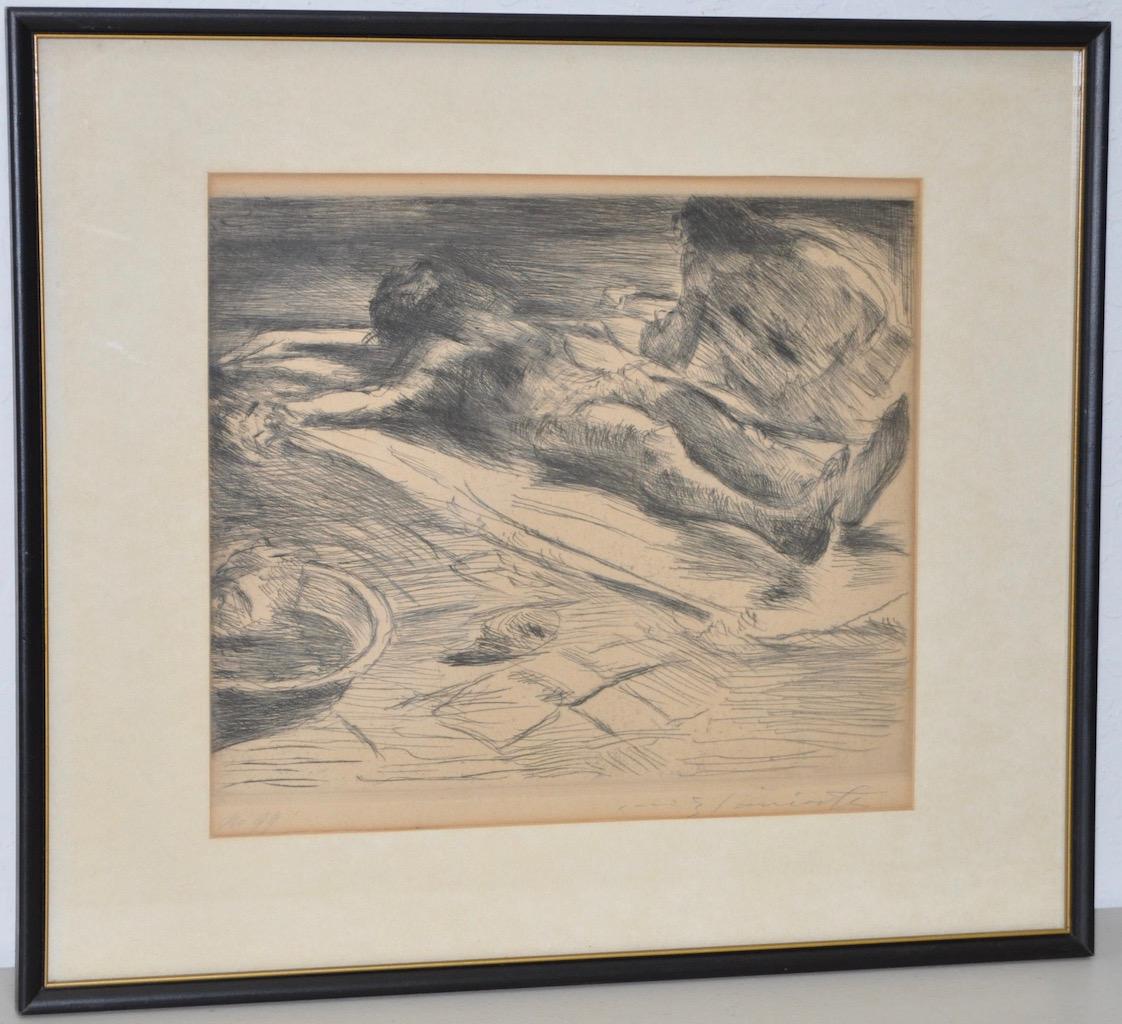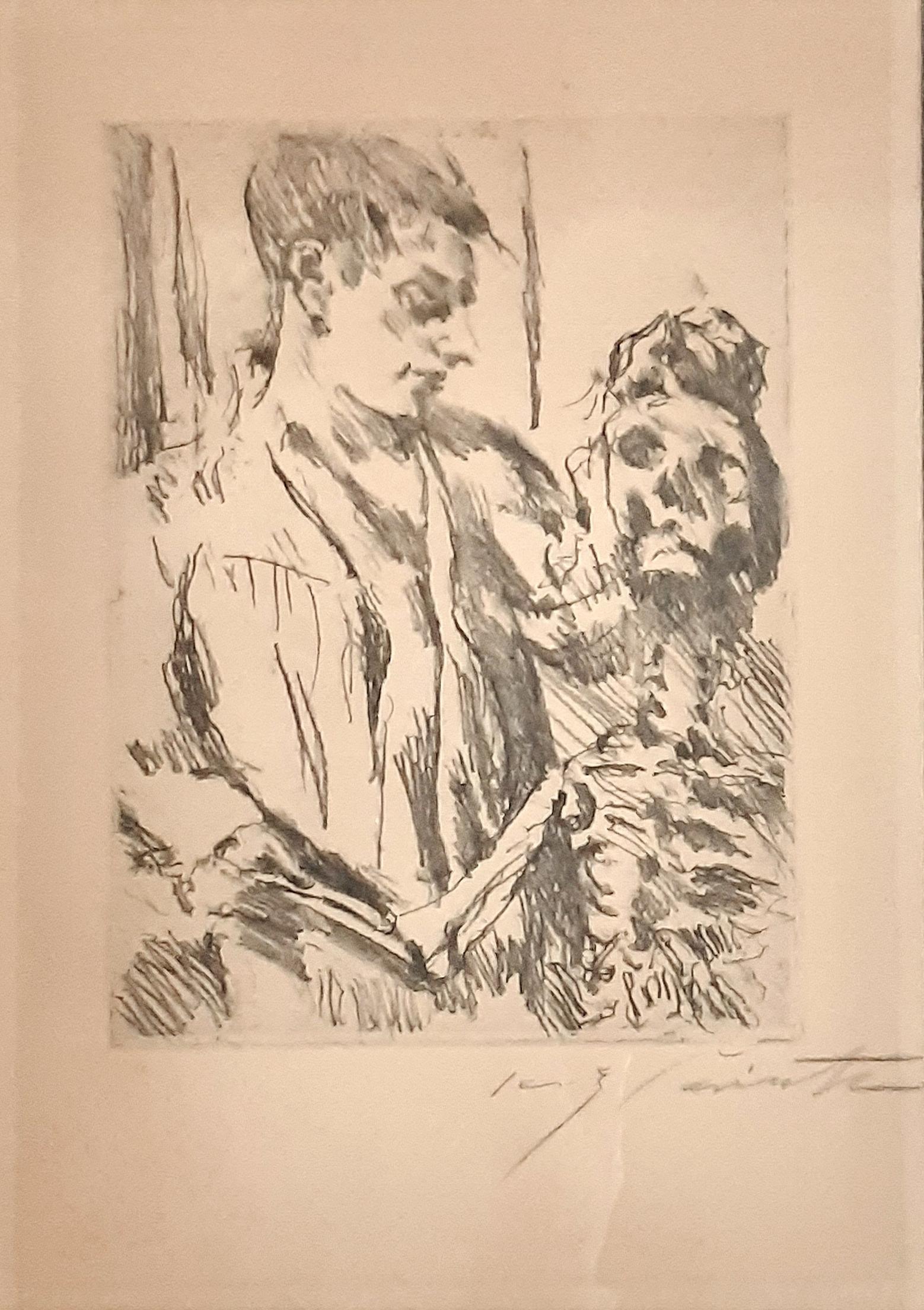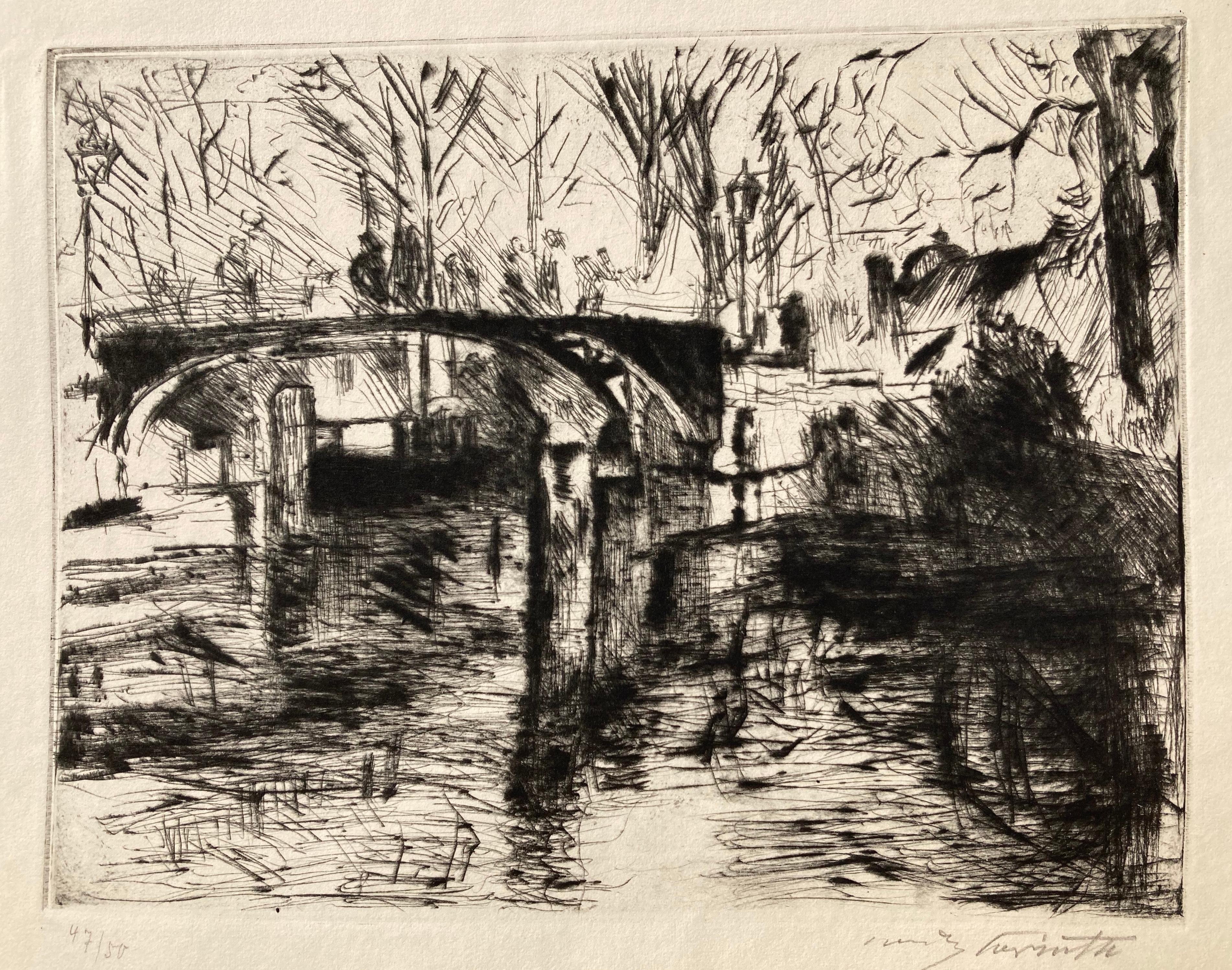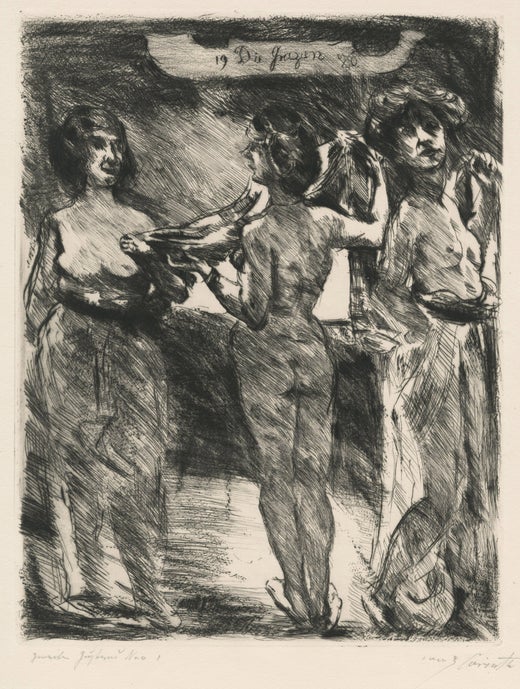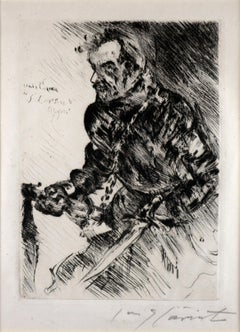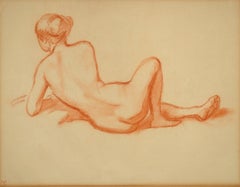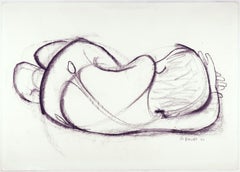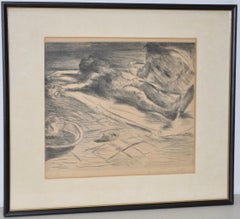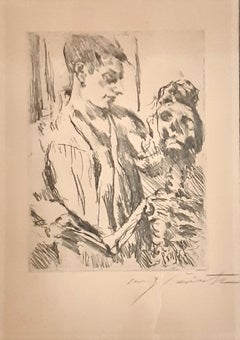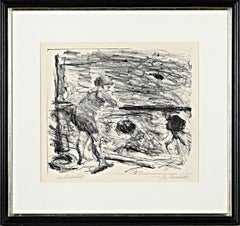Items Similar to In bed / - Reverie -
Want more images or videos?
Request additional images or videos from the seller
1 of 8
Lovis CorinthIn bed / - Reverie -
$705
$881.2520% Off
£539.86
£674.8320% Off
€600
€75020% Off
CA$990.88
CA$1,238.6020% Off
A$1,086.94
A$1,358.6820% Off
CHF 568.70
CHF 710.8820% Off
MX$12,936.75
MX$16,170.9420% Off
NOK 7,183.08
NOK 8,978.8520% Off
SEK 6,737.86
SEK 8,422.3220% Off
DKK 4,570.76
DKK 5,713.4520% Off
About the Item
Lovis Corinth (1858 Tapiau - 1925 Zandvoort), In bed, 1909. Drypoint on laid paper with watermark, 14.3 cm x 19 cm (image), 29 cm x 39.3 cm (sheet size), signed “Lovis Corinth” in pencil lower right.
- the wide margin partially wavy and with tidemark lower right, minimally light-stained and slightly stained
- Reverie -
The etching depicts Lovis Corinth's wife, Charlotte Berend-Corinth. It is likely a portrait taken after the birth of their daughter, Wilhelmine, as indicated by her bare décolletage. Her hand with the wedding ring rests there as well. Her gaze is directed almost dreamily upward. This creates an atmosphere of relaxed fulfillment, reinforced by the etching needle's breathy yet concise style.
About the artist
Determined to become an artist, Corinth entered the Königsberg Art Academy in 1876, where he studied under Otto Günther, who introduced him to Weimar plein-air painting. On Günther's recommendation, Corinth moved to the Munich Art Academy in 1880. There, under the influence of the circle of Leibl and Wilhelm Trübner, he adopted a naturalistic approach to art that was opposed to academic history painting.
After interrupting his studies for a year to do voluntary military service, Corinth went on a study trip to Italy in 1883 and the following year to Antwerp, where he took art lessons from Paul Eugène Gorge. From 1884 to 1887, Corinth stayed in Paris and devoted himself mainly to nude painting at the private Académie Julian.
After a stopover in Berlin, where he met Max Klinger, Walter Leistikow and Karl Stauffer-Bern, Corinth lived in Munich from 1891 to 1901 and became a founding member of the Munich Secession, which was founded in 1892 by Max Liebermann, Otto Eckmann, Thomas Theodor Heine, Hans Olde, Hans Thoma, Wilhelm Trübner, Franz von Stuck and Fritz von Uhde. The Secession gave rise to the Free Association of the XXIV or Munich 24, to which Corinth also belonged.
In 1894, under the tutelage of Otto Eckmann, Corinth learnt the art of etching and, in the field of painting, developed the wet-on-wet style that would characterise his work and lead to the relief-like texture of his paintings.
His relationship with Berlin became more and more intense. When he attended the first exhibition of the Berlin Secession in 1899, he painted a portrait of Liebemann, who in turn painted a portrait of Corinth. After the Munich Secession rejected his painting Salome, he finally moved to Berlin, where the painting was admired at the Secession exhibition and Corinth - through Leistikow - became a much sought-after portraitist.
In 1903 Corinth opened an art school and in 1904 he married his first pupil, Charlotte Berend. His first solo exhibition was organised by Paul Cassirer. In Berlin, Corinth also began to devote himself to the theatre. He worked with Max Reinhardt, designing sets and costumes.
Following Max Liebermann's resignation, Corinth was elected chairman of the Secession in 1911. In the same year, he suffered a stroke that paralysed half of his body. He then devoted himself intensively to graphic art and opened up the field of book illustration.
In 1913, Paul Cassirer organised the first major retrospective of Corinth's work, and in 1918, on his 60th birthday, the Berlin Secession devoted a major exhibition to his work. In 1923, on his 65th birthday, his artistic career was crowned with a extense solo exhibition at the National Gallery.
Even after the 'Freie Sezession' split from the 'Berliner Sezession', Corinth remained in the original association, becoming chairman again in 1915 and professor at the Berlin Academy of Arts the following year.
In 1919, the Corinths purchased the retreat at the Walchensee in Bavaria, which Corinth captured in more than 60 paintings. Corinth died in 1925 on a trip to Amsterdam to see his great idols, Frans Hals and Rembrandt.
GERMAN VERSION
Lovis Corinth (1858 Tapiau - 1925 Zandvoort), Im Bett, 1909. Kaltnadelradierung auf Büttenpapier mit Wasserzeichen, 14,3 cm x 19 cm (Darstellung), 29 cm x 39,3 cm (Blattgröße), rechts unten in Blei mit „Lovis Corinth“ signiert.
- der breite Rand teilweise gewellt und rechts unten mit Wasserrand, minimal lichtrandig und leicht fleckig
- Reverie -
Die Radierung zeigt Lovis Corinths Frau, Charlotte Berend-Corinth, wohl nach der Geburt der gemeinansamen Tochter Wilhelmine, worauf das entblößte Dekolleté verweist. Dort ruht auch die Hand mit dem Ehering. Der Blick ist beinahe träumerisch nach oben gerichtet. Es entsteht die Atmosphäre einer gelösten Erfülltheit, die vom gehauchten und dennoch prägnanten Duktus der Radiernadel verstärkt wird.
zum Künstler
Entschlossen Künstler zu werden, trat Corinth 1876 in die Kunstakademie Königsberg ein, wo er bei Otto Günther studierte, der ihm die Weimarer Freilichtmalerei nahebrachte. Auf Günthers Empfehlung wechselte Corinth 1880 an die Münchner Kunstakademie. Unter dem Einfluss des Leibls-Kreises und Wilhelm Trübners folgte er dort einem naturalistischen Kunstverständnis, das gegen die akademische Historienmalerei gerichtet war.
Nach einer einjährigen Studienunterbrechung zur Ableistung eines freiwilligen Militärdienstes begab sich Corinth 1883 auf eine Studienreise nach Italien und im Folgejahr nach Antwerpen, wo er bei Paul Eugène Gorge Kunstunterricht nahm. 1884-1887 weilte Corinth in Paris und widmete sich an der privaten Académie Julian vor allem der Aktmalerei.
Nach einer Zwischenstation in Berlin, wo er Max Klinger, Walter Leistikow und Karl Stauffer-Bern kennenlernte, lebte Corinth von 1891-1901 in München und wurde Gründungsmitglied der 1892 ins Leben gerufenen Münchener Secession, der sich Max Liebermann, Otto Eckmann, Thomas Theodor Heine, Hans Olde, Hans Thoma, Wilhelm Trübner, Franz von Stuck und Fritz von Uhde anschlossen. Aus der Sezession ging die Abspaltung Freie Vereinigung der XXIV oder Münchner 24 hervor, zu der auch Corinth gehörte.
Von Otto Eckmann angeleitet erlernte Corinth 1894 die Kunst des Radierens und entwickelte auf dem Feld der Malerei die für sein Werk prägende Nass-in-Nass-Malerei, die zum reliefartigen Duktus seiner Gemälde führte.
Die Beziehungen nach Berlin wurden immer intensiver. Als er 1899 zur ersten Ausstellung der Berliner Secession fuhr porträtierte er Liebemann, der seinerseits ein Porträt von Corinth anfertigte. Nachdem die Münchner Sezession sein Bild Salome abgelehnt hatte, zog er endgültig nach Berlin, wo das Gemälde auf der dortigen Sezessionsausstellung Bewunderung fand und Corinth – von Leistikow vermittelt – zum gefragten Porträtmaler wurde.
1903 eröffnete Corinth eine Malerschule und heiratete 1904 seine erste Schülerin Charlotte Berend. Von Paul Cassirer veranstaltet erfolgte die erste Einzelausstellung. In Berlin begann sich Corinth auch dem Theater zu widmen. Er arbeitete mit Max Reinhardt zusammen, entwarf Bühnenbilder und Kostüme.
Nach dem Rücktritt Max Liebermanns wurde Corinth 1911 zum Vorsitzenden der Secession gewählt. Im selben Jahr erlitt er einen Schlaganfall, der ihn halbseitige lähmte. In der Folge wandte er sich intensiv der Grafik zu und erschloss sich das Feld der Buchillustration.
1913 veranstaltetet Paul Cassirer die erste große Retrospektive und zum 60. Geburtstag Corinths widmete ihm die Berliner Secession 1918 eine großangelegte Werkschau. 1923, zu seinem 65. Geburtstag, wurde seine künstlerische Karriere mit einer umfassenden Einzelausstellung in der Nationalgalerie gekrönt.
Auch nach der Abspaltung der "Freien Secession" von der "Berliner Secession" verblieb Corinth in der ursprünglichen Vereinigung und wurde 1915 erneut Vorsitzender und im Folgejahr zum Professor an der Berliner Akademie der Künste ernannt.
1919 erwarben die Corinths den Rückzugsort am bayerischen Walchensee, den zu Corinths in über 60 Bildern festhielt. Auf einer Reise nach Amsterdam zu seinen großen Vorbildern Frans Hals und Rembrandt verstarb Corinth im Jahre 1925.
- Creator:Lovis Corinth (1858 - 1925, German)
- Dimensions:Height: 11.42 in (29 cm)Width: 15.36 in (39 cm)Depth: 0.4 in (1 cm)
- Medium:
- Movement & Style:
- Period:
- Condition:
- Gallery Location:Berlin, DE
- Reference Number:1stDibs: LU2438216514122
Lovis Corinth
Lovis Corinth was a German artist and writer whose mature work as a painter and printmaker realized a synthesis of impressionism and expressionism, known for his dramatic figurative and landscape paintings also for his landscapes of the Walchensee area of Bavaria and his portraits, Corinth also painted religious scenes, often violent . He also made etchings and lithographs in which he revealed his capacity for Expressionist power.
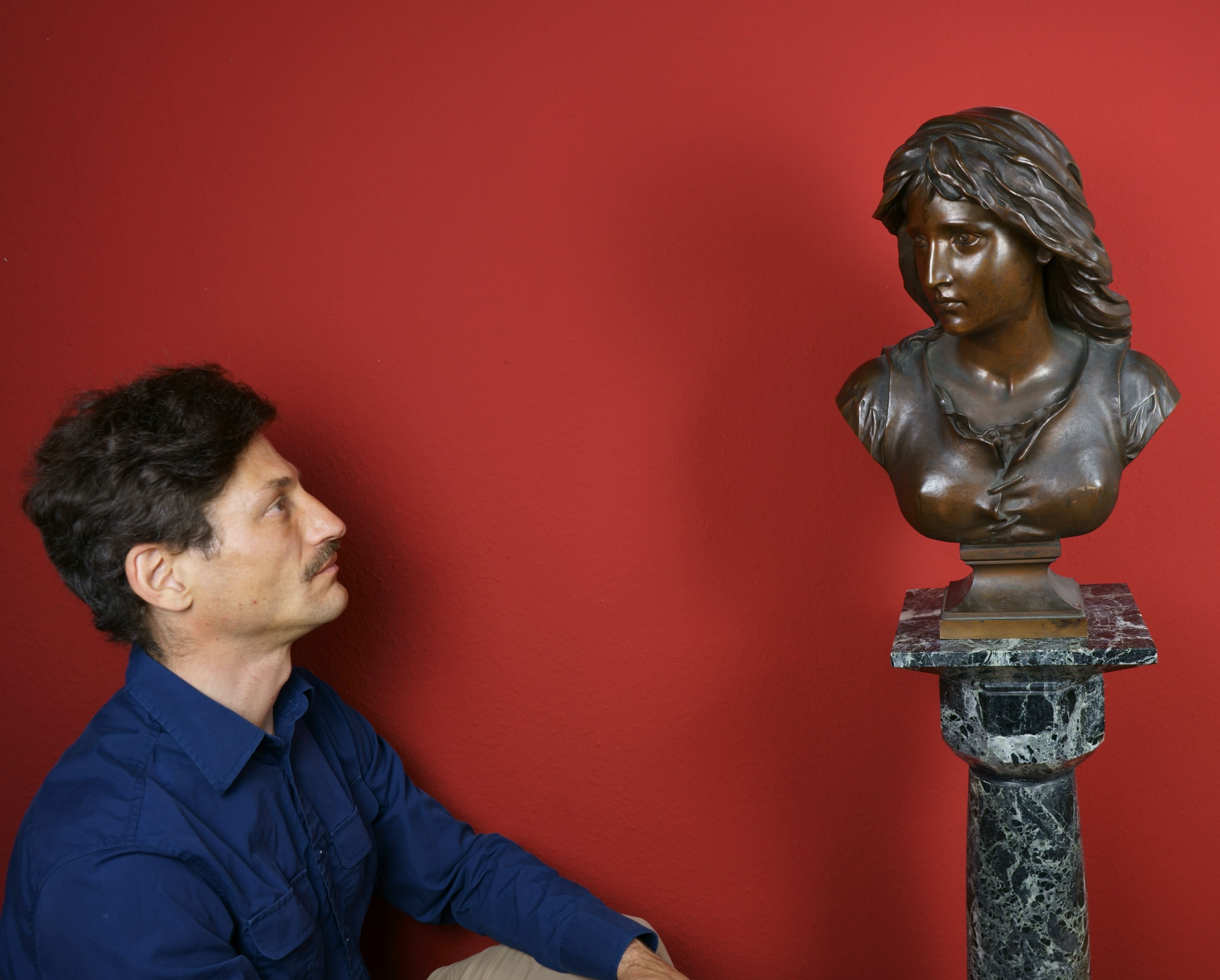
About the Seller
5.0
Vetted Professional Seller
Every seller passes strict standards for authenticity and reliability
Established in 2014
1stDibs seller since 2023
22 sales on 1stDibs
- ShippingRetrieving quote...Shipping from: Berlin, Germany
- Return Policy
More From This Seller
View AllRudolf v. Rittner as Florian Geyer - Last man standing -
By Lovis Corinth
Located in Berlin, DE
Lovis Corinth (1858 Tapiau - 1925 Zandvoort), Rudolf von Rittner as Florian Geyer, 1924 (Müller 854), drypoint signed in pencil. 20.4 × 14.2 (plate size), 37.7 × 30.6 cm (sheet size). Published by Karl Nierendorf, Berlin. Framed in a passepartout.
- Strong, precise impression. Frame a little bit rubbed and with two small damages.
About the artwork
The knight is a leitmotif in Lovis Corinth's work, culminating in his Self-Portrait in Armour of 1914. Of all the paintings on this theme, Corinth most often depicted Florian Geyer. Descended from a Franconian noble family, he fought for the freedom of the peasants during the peasant wars of the Reformation, first diplomatically and then militarily, leading the legendary Schwarzen Haufen (Black Troops). The name derives from the black uniforms with which Geyer dressed the peasants willing to fight.
During the Napoleonic occupation, the freedom fighter Florian Geyer was sung about by the Romantics, and the free corps Die Schwarze Schaar, founded in 1813 by Major von Lützow, succeeded the Schwarzer Haufen. It was against this historical background that Gerhard Hauptmann wrote the revolutionary drama Florian Geyer, which premiered at the Deutsches Theater in Berlin in 1896. While the actor Rudolf Rittner, who would later appear in Fritz Lang's films, initially played the role of Schäferhans, he took over the leading role in the new production at Berlin's Lessing Theatre in 1904, again directed by Emil Lessing, which established his fame as an actor. Hauptmann himself praised the acting. He wrote to Hugo von Hofmannsthal: "It went quite well with Florian Geyer. In any case, I had the great pleasure of seeing the play again in an admirable performance". And Lovis Corinth was so taken with Rittner's performance that he painted an oil portrait of him in the role of Florian Geyer in 1906.
After two further graphic versions in 1915 and 1920/21, Corinth returned to the painting a year before his death and almost twenty years after the oil painting to create this graphic version in 1924. Even the inscription in the picture was taken over. This proves all the more the importance of the knight and freedom fighter for Corinth's self-image.
The oil painting, in particular, proclaims the single-minded determination to fight to the last for the values defended, manifested in the oil painting by the tattered flag held out to the enemy. There is a parallel with Rainer Maria Rilke's 1899 story The Cornet, in which the protagonist goes down with the flag that he first saved at the risk of his life.
Consequently, the portrait is also a self-portrait, and the knight's armour is not an academic costume or an ironic refraction, but an expression of Corinth's self-image, which also includes his self-representation as an artist. The Secession poster...
Category
1920s Expressionist Figurative Prints
Materials
Etching
$893 Sale Price
20% Off
Female Nude Sitting on a Sofa
Located in Berlin, DE
Wilhelm Trübner (1851 Heidelberg - 1917 Karlsruhe), Female Nude Sitting on a Sofa, around 1900. Pencil drawing, 32.5 x 48.5 cm, monogrammed “W.T.” lower left and inscribed on the rev...
Category
Early 1900s Realist Nude Drawings and Watercolors
Materials
Paper
$1,692 Sale Price
20% Off
Female Nude from the Back, around 1900 / - The contour of the Art Nouveau -
By Ludwig von Hofmann
Located in Berlin, DE
Ludwig von Hofmann (1861 Darmstadt - 1945 Pillnitz), Female nude from the back, around 1900. Red chalk drawing on watermarked drawing paper, 36 cm x 44 cm (sheet size). Artist's liga...
Category
Early 1900s Art Nouveau Nude Drawings and Watercolors
Materials
Paper
Lying Boy / - Fragile childlikeness -
Located in Berlin, DE
Alfred Fuchs (1925 Saarbrücken - 2003 Prague), Lying Boy. Charcoal drawing on strong paper, 30 x 41.5 cm, signed A.[lfred] Fuchs and dated [19]96.
- smal...
Category
1990s Realist Figurative Drawings and Watercolors
Materials
Charcoal
$517 Sale Price
20% Off
The Mother / - Violated Motherhood -
By Georg Tappert
Located in Berlin, DE
Georg Tappert (1880 Berlin - 1957 Berlin), The Mother, 1918 (1964). Estate print from 1964. Linocut on Japan, 31.5 cm x 20 cm (image), 44.5 cm x 28 cm (sheet size), marked lower left...
Category
1910s Expressionist Figurative Prints
Materials
Paper
$263 Sale Price
20% Off
The completely naked prostration
Located in Berlin, DE
Willibrord Haas (*1936 Schramberg), The completely naked prostration, 1999. Etching, 32.5 cm x 23.5 cm (plate size), 54 cm x 37.5 cm (sheet size). Signed “Willibrord Haas” in lead by...
Category
1990s Realist Nude Prints
Materials
Paper
$272 Sale Price
20% Off
You May Also Like
WEIBLICHER AKT MIT BREITKREMPIGEM HUT
By Lovis Corinth
Located in Portland, ME
Corinth, Lovis. WEIBLICHER AKT MIT BREITKREMPIGEM HUT (Female Nude with Broad-Brimmed Hat). Schwartz 226A. Etching, 1916. 11 3/4 x 7 3/4 inches, 300 x 198 mm. The earlier version, be...
Category
1910s Portrait Prints
Materials
Etching
Lovis Corinth (German, 1859-1925) "Pieta" Rare Etching c.1920
By Lovis Corinth
Located in San Francisco, CA
Lovis Corinth (German, 1859-1925) Rare Etching c.1920
Fine etching by noted German Expressionist artist Lovis Corinth.
This striking imag...
Category
Early 20th Century Impressionist Figurative Prints
Materials
Etching
Tod und Jungling - Lithograph by L. Corinth - 1921
By Lovis Corinth
Located in Roma, IT
Tod und Jungling is an original lithograph, realized by Lovis Corinth in 1921, hand-signed and numbered n°33/95.
Included a wooden frame.
In very good conditions.
Here the artworks represented a man with a strong expression of lines drawn, who has caught with his hand a skeleton, interestingly the skeleton has a sense of fear although the man is free of any frightening emotions.
Lovis Corinth (1858-1925) was a German artist and writer whose mature work as a painter and printmaker realized a synthesis of impressionism and expressionism. known for his dramatic figurative...
Category
1920s Figurative Prints
Materials
Lithograph
Lovis Corinth, Badeanstalt 1920, Lithograph, Hand-Signed , German Impressionist
By Lovis Corinth
Located in Eltville am Rhein, DE
Lovis Corinth
Tapiau 1858 - 1925 Zandvoort
Bathing Establishment, 1920
Lithograph on handmade paper
Signed in pencil lower right
Marked "Probedruck" (proof print) lower left
Image ...
Category
1920s Impressionist Figurative Prints
Materials
Lithograph
AUS DEM TIERGARTEN
By Lovis Corinth
Located in Santa Monica, CA
LOVIS CORINTH (1858-1925)
AUS DEM TIERGARTEN 1920 (Schwartz 397)
Drypoint, signed and numbered 47/50. BEAUTIFUL IMPRESSION with RICH DRYPOINT. Plate 9 ½ x 12 ½ inches. Full margins...
Category
1920s Impressionist Prints and Multiples
Materials
Drypoint
Femme couchée - Réveil - Lithograph after H. de Toulouse-Lautrec-1896
By Henri de Toulouse-Lautrec
Located in Roma, IT
Femme couchée - Réveilis a color lithograph realized after Henri de Toulouse Lautrec in 1896.
cm. 58 x 45,5; matted.
This specimen belongs to an edition of 1900 ca., whose dimensi...
Category
1890s Post-Impressionist Portrait Prints
Materials
Lithograph, Paper
